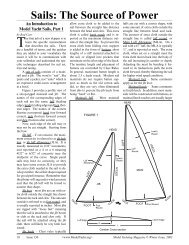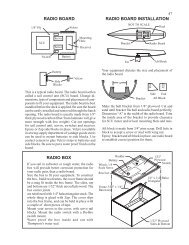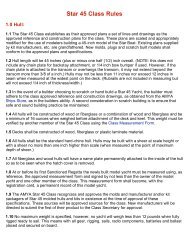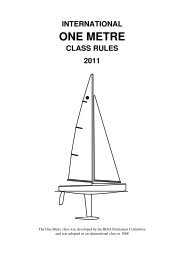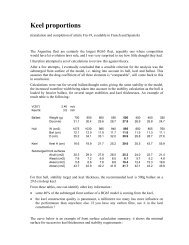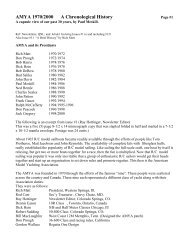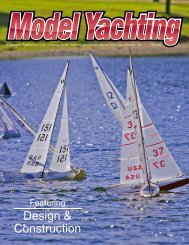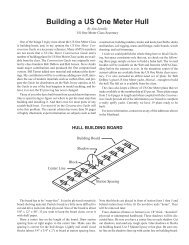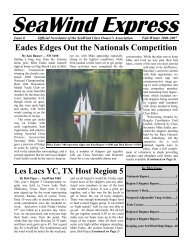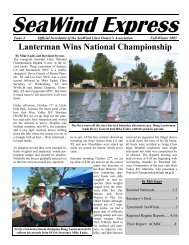SeaWind Express - American Model Yachting Association
SeaWind Express - American Model Yachting Association
SeaWind Express - American Model Yachting Association
You also want an ePaper? Increase the reach of your titles
YUMPU automatically turns print PDFs into web optimized ePapers that Google loves.
<strong>SeaWind</strong> <strong>Express</strong><br />
Issue 2 Official Newsletter of the <strong>SeaWind</strong> Class Owner’s <strong>Association</strong> Fall-Winter 2004<br />
Region One<br />
Champion<br />
Crowned in<br />
Connecticut<br />
By Ken Bauser — <strong>SeaWind</strong> #110<br />
After a week’s delay due to foul weather,<br />
the Region One Seawind Class Championship<br />
was successfully accomplished on<br />
August 28, 2004 at Hop Brook Lake,<br />
Middlebury, Connecticut. Hosted by the<br />
Housatonic <strong>Model</strong> Yacht Club, AMYA<br />
#117, ten races (with one throw-out) were<br />
sailed in light and variable winds. After<br />
losing several entries due to the postponement,<br />
we still had nine eager skippers answer<br />
the starting bell for the races ably<br />
run by Dick Hovey, Race Director, who<br />
was assisted by Dan Olah.<br />
Participants arrived bright and early and<br />
check-in went without a hitch. The club’s<br />
standard race course was used, with the<br />
now-in-vogue windward/leeward marks<br />
set up with the option of using “gates” or<br />
specified turn and offset marks. While<br />
some skippers pretty much remained ensconced<br />
in their “cabanas” (i.e. under<br />
their shade-providing golf umbrellas),<br />
By Jay Barnes #2, Tom Williams # 80<br />
and Mike Eades # 89.<br />
October 23/24 saw the West Valley R/C<br />
Mariners club host the Region 5 <strong>SeaWind</strong><br />
Class Championship Regatta at Litchfield<br />
Park Lake, Arizona. Weather forecast,<br />
clear sunny skies with 75-degree temperatures<br />
and easterly winds, 5-15 mph! Well,<br />
two out of three is not bad except when<br />
you are planning a regatta<br />
A small fleet of seven yachts gathered for<br />
the tune-up event Saturday, held under the<br />
club’s 1-Meter Sport Rules.<br />
Close competition at the start of one of the many heats at the Region 1 regatta.<br />
others walked the course in the humiditydrenched<br />
sun. At the break for lunch, Walt<br />
Chapman and Ken Bauser were deadlocked<br />
in a tie for first, followed by Tony Bosco<br />
and Fred Harwood – who we were very<br />
pleased to have come out of retirement to<br />
sail in this regatta, and who sailed some<br />
very strong races despite all that dust on his<br />
boat! During the afternoon races, Walt<br />
stayed cool and calm, (Continued on page<br />
3)<br />
In This Issue<br />
Region 1 Championship Report….....1<br />
Region 5 Championship Report….....1<br />
Secretary’s Desk…………...…………2<br />
Tech Corner……...….…………….…7<br />
Fleet Reports.……...………….……4,6<br />
WVRCM Hosts Region 5 Championship Regatta<br />
“Texasbob” Harmon had flown in from<br />
Dallas with his beautifully painted yacht<br />
“Tejas” and took advantage of the 1-MS<br />
formula to test his new homemade sail set<br />
and several skippers were brushing the<br />
dust off their boats and sailing skills<br />
Winds, although light and shifty, generally<br />
allowed for some spirited competition<br />
and the full 12-race event was completed<br />
in just under 4 hours including a short<br />
lunch break. Mike Eades narrowly edged<br />
out Tom Williams by one point while Jay<br />
Barnes also held off Ben Kowaliski by<br />
one point for third place. Bob Harmon<br />
and Rowland Stevens tied for fifth place.<br />
Sunday dawned with a light easterly<br />
breeze already showing as skippers gathered<br />
for the main event. Believing the<br />
forecast, a good size course was set for<br />
the 9-yacht fleet. Regatta Director Jay<br />
Barnes introduced Dennis Desprois of the<br />
Copperstate MYC, an experienced 36/600<br />
and Marblehead skipper and sailmaker/<br />
boat-builder, who had kindly agreed to<br />
serve as Race Director. After a skippers<br />
briefing on the (Continued on Page 4)
Seawind <strong>Express</strong> Page 2<br />
SCOA:<br />
From the<br />
Secretary’s Desk<br />
STATE OF THE SEAWIND COA<br />
By Mike Eades, <strong>SeaWind</strong> # 89<br />
Your <strong>SeaWind</strong> COA continues to grow<br />
steadily, reaching a number of new milestones<br />
over the past six months. Membership<br />
at mid October stands at 85 registered<br />
skippers with 95 yachts. The number<br />
of AMYA members stands at around<br />
63 although this number fluctuates as<br />
each membership comes up for renewal.<br />
It helps both AMYA and the COA if you<br />
renew your AMYA membership on time<br />
and remind Michelle that you have a<br />
<strong>SeaWind</strong>. The Treasury stands at<br />
$306.73. I received payment from<br />
AMYA for past <strong>SeaWind</strong> registrations<br />
By Bob Harmon — <strong>SeaWind</strong> #37<br />
Although I had raced and sailed boats for<br />
over twenty years, I had never tried RC<br />
sailing. This changed during a trip to<br />
Phoenix, AZ to throw a party for my father-in-laws<br />
80 th birthday.<br />
While at one of the local recreation centers,<br />
I spied a bunch of <strong>SeaWind</strong>s sailing<br />
on the lake. It was the Sun City Canyonstate<br />
YC holding their weekly races. I<br />
wandered down to have a look. The first<br />
person I talked to was Mike Eades (our<br />
illustrious SCOA class secretary). Mike<br />
was kind enough to take the time to show<br />
me his boat, explain about the class, and<br />
even let me sail his boat around.<br />
I was very impressed with the detail of<br />
the boat and its sailing responsiveness. I<br />
especially liked the one-design rules<br />
where sailing ability counts and not how<br />
much money one can throw into a boat.<br />
Back at my father-in-laws, I checked out<br />
the web site and was even more impressed.<br />
Upon returning to Dallas, TX, I<br />
ordered my first <strong>SeaWind</strong>. While waiting<br />
for my <strong>SeaWind</strong> to arrive, I proceeded<br />
to read all the forums on the web<br />
and was up to date in mid year although<br />
I understand they have received<br />
a further 4 registrations which have not<br />
yet been paid to us. I will be paying for<br />
a fresh supply of “S” logos and the<br />
stationery and postage costs of the upcoming<br />
ballot in Q1 2005 but there<br />
should still be a nice positive balance.<br />
I am very encouraged by the emergence<br />
of some new fleets of <strong>SeaWind</strong>s.<br />
I have received a number of comments<br />
that our Class Rules close adherence to<br />
the stock kit is attractive to members<br />
who are tired of chasing spec changes<br />
in other quasi-one-design classes. The<br />
new Air Capitol MSC in Wichita has<br />
had a very successful first season, as<br />
has the Sacramento MYC, CA with its<br />
first season under SCOA Rules. The<br />
Naples MYC, FL has embraced the<br />
members of the Royal Amberwood<br />
Yacht Squadron in a new Seawind fleet<br />
and most recently the Wis-Illin Winds<br />
Club in Racine, WI has begun to<br />
SCOA Class Officers:<br />
Secretary……...…..…....Mike Eades<br />
Technical Advisor…...…Ken Bauser<br />
AMYA Regional Directors<br />
Region 1 (NE).………....Ken Bauser<br />
Region 4 (Central)...….Philip Sarelis<br />
Region 5 (SW)…….. …..Jay Barnes<br />
Region 6 (NW)…...Doug Lanterman<br />
Newsletter Editor.…...…..Andy Rust<br />
A Sailor’s Tale: Discovering RC Sailing With the <strong>SeaWind</strong><br />
Bob Harmon’s three <strong>SeaWind</strong>s: The ‘Mermaid’, ‘Tejas 1’ and ‘Piranha’<br />
site. Unfortunately, I travel a lot for<br />
business and was gone for a couple of<br />
weeks when the box arrived.<br />
I finally returned to start construction. I<br />
wanted to take my time to make the boat<br />
as nice as possible. In addition to waterproofing<br />
the hatch, I had already decided<br />
assemble a <strong>SeaWind</strong> fleet. I would like to<br />
welcome all to the <strong>SeaWind</strong> COA and thank<br />
the Club Officers for assisting the establishment<br />
of this new Class.<br />
Our first Regional Championships have<br />
been reported elsewhere. Congratulations to<br />
our Champions and thanks to all skippers<br />
who took part. We now have an excellent<br />
line of communication and working relationship<br />
with both product management and<br />
technical support (Continued on page 11)<br />
to paint the boat and install a magnetic<br />
switch. I was still traveling about every<br />
other week and when at home my wife<br />
was coming up with her list of “to do’s”<br />
around the house.<br />
The bottom prep, mask, paint, re-mask,<br />
paint, sand, etc. (Continued on page 6)
Seawind <strong>Express</strong> Page 3<br />
(Continued from page 1) continuing his<br />
consistency to finish the regatta in first<br />
place, while Ken wilted a bit, winding up<br />
in the second spot. Tony held onto third,<br />
while Dick Chandler got his boat going<br />
for a fourth overall. Ted Kennedy sailed<br />
a solid regatta and wound up fifth.<br />
With our first-ever Seawind Regional on<br />
the books, we are proud to have a well<br />
deserving Walt Chapman – one of the<br />
very original Seawind owners, and sailing<br />
Seawind registration number 1 – as the<br />
Region One Champion. Walt sailed a<br />
very consistent series, especially considering<br />
the “variable” nature of the conditions.<br />
Trophies were awarded for places<br />
1 through 4, and AMYA provided chevrons<br />
for 1,2,3. Once scoring was transcribed<br />
and results made “official”, a<br />
copy of the score sheet along with a certificate<br />
recognizing participation<br />
(beautifully produced by Walt’s daughter<br />
Barbara) were presented to each skipper.<br />
A big THANK YOU goes to Dick Hovey,<br />
with the assistance of Dan Olah, for a fantastic<br />
job of running the races. A special<br />
thanks also to all the skippers attending<br />
from around the state of Connecticut, as<br />
well as New York. They were a truly<br />
“high grade” group of competitors who<br />
all made Seawind Region One proud!<br />
Editor’s Note: Congratulations to Walt<br />
Chapman—who just happens to have<br />
sail #1, taking first place in the first ever<br />
Region 1 regatta!<br />
By Ken Bauser — SCOA Tech Advisor<br />
It was our club’s end of season regatta,<br />
and a “run what you brung” affair. What<br />
better time, I thought, than to break out<br />
my Marblehead Class yacht and show the<br />
“plastic boat” crowd what 50” of carbon<br />
and Kevlar can do!<br />
That was my plan, but by lunch break I<br />
was faced with the reality that more often<br />
than not I was finding myself slugging it<br />
out with several <strong>SeaWind</strong>s, and finishing<br />
behind a couple of them far too often.<br />
Something smelled real fishy, and I decided<br />
I needed to find out what was going<br />
on here. With our club having recently<br />
completed the <strong>SeaWind</strong> Region One<br />
Championship regatta, I determined I’d<br />
Walt Chapman takes a break from the sun next to his <strong>SeaWind</strong> #1 at the Reg. 1 Regatta<br />
Region 1 Championship Regatta — Results<br />
Place Skipper Points<br />
1 Walt Chapman 14<br />
2 Ken Bauser 20<br />
3 Tony Bosco 29<br />
4 Dick Chandler 36<br />
5 Ted Kennedy 40<br />
6 Fred Harwood 44<br />
7 Ray Meier 61<br />
8 Dick Mohr 69<br />
9 Joe Gregorzek 71<br />
‘Investigative Report’: The Gear of the Winners<br />
take a closer look at the trophy winners’<br />
boats. These guys must have some serious<br />
go-fast gear aboard!<br />
First stop was the fourth place finisher, and<br />
this fellow looked like he might have<br />
something to hide, but his one year old<br />
boat proved almost entirely stock, including<br />
outhauls, rudder linkages, and even all<br />
stock cordage for standing and running<br />
rigging. He even uses the stock hatch, but<br />
with screw-downs added, along with a better<br />
foam seal. No bulb boot was in evidence,<br />
but that’s all I got on this one.<br />
On to the number three finisher, and I was<br />
convinced that this veteran <strong>SeaWind</strong> skipper,<br />
with a model boat shop bigger than<br />
the Taj Mahal, would have all the bells and<br />
whistles on his boat. I had seen his first<br />
<strong>SeaWind</strong>, and it was tricked out to the<br />
max, but the three year old boat (with<br />
original sails) he raced at the Regionals<br />
looked surprisingly stock to me. Heck,<br />
even the bulb boot was in place, along with<br />
all kit supplied rudder linkage parts. While<br />
he used the stock kit supplied cord and<br />
clips for standing rigging, he did have 20<br />
lb. test Dacron braid for the sheeting system.<br />
His outhauls were box stock, and he<br />
ran a standard hatch cover but with a foam<br />
seal material used under pickup truck caps.<br />
So far I was coming up empty, and getting<br />
a look at the second place boat might be a<br />
little more (Continued on page 10)
Seawind <strong>Express</strong> Page 4<br />
Fleet Report: Air Capitol <strong>Model</strong> Sailing Club<br />
By Andy Rust — <strong>SeaWind</strong> #28<br />
As I write this article, the movie “Field of<br />
Dreams” truly comes to mind, and in particular<br />
the recognizable quote of, “If you<br />
build it, they will come”. The formation<br />
of the Air Capitol <strong>Model</strong> Sailing Club in<br />
Wichita, Kansas has been a remarkable<br />
and fulfilling success story that continues<br />
to unfold. Our new club has gone from a<br />
mere idea in December 2003, to a fully<br />
functioning and active club as of October<br />
that has seen as many as thirteen boats on<br />
the water in a regatta.<br />
When our club was officially established<br />
with the AMYA in January (as club<br />
#172), there were two <strong>SeaWind</strong>s—my<br />
boat, and one based in Oklahoma City<br />
(about 2 ½ hours drive from Wichita).<br />
However, over the past eight months that<br />
number has grown to nine, with eight of<br />
those located in the local area. Officially,<br />
our club has eight <strong>SeaWind</strong> skippers/<br />
owners.One of the keys to this steady<br />
growth rate has been the adoption of the<br />
One Meter Sport class format. This strategy<br />
allows for skippers with a variety of<br />
boat types to participate, while showcasing<br />
the strengths of the <strong>SeaWind</strong>. The<br />
idea behind the One Meter Sport philosophy<br />
comes originally from the West<br />
The ACMSC <strong>SeaWind</strong> fleet has grown from just two boats to nine in just one season.<br />
(pictured are five of the eight locally-owned <strong>SeaWind</strong>s in the club)<br />
Valley RC Mariners, in Sun City, AZ. Essentially<br />
these are the rules: Any commercially<br />
available kit-based boat (must be<br />
available from retail outlets/hobby shops)<br />
that is between 33” and one meter. Modifications<br />
are only permitted above the waterline,<br />
and can include aftermarket sails—<br />
so long as they conform to the original kit<br />
sail dimensions, and carbon fiber spars.<br />
Photo by Brooke Williams<br />
They’re off! A close start at the Region 5 Championship Regatta.<br />
Photo by Wendy Olson<br />
However, mostly stock <strong>SeaWind</strong>s have<br />
won and scored in the top 3 in each of the<br />
six regattas our club has held—regularly<br />
beating Victor Cup Class one meter boats<br />
and Northwind 36’s. I believe this is due<br />
in large part to the excellent design and<br />
performance of the boat, when tuned and<br />
sailed properly. Slowly (or so it seems)<br />
(Continued on page 5)<br />
(Reg. 5 Regatta—cont. from page 1)<br />
sailing instructions Dennis called the<br />
boats to the line for the first race. The<br />
wind soon showed its fickle nature by diminishing<br />
to a few tantalizing zephyrs that<br />
produced ripples in one part of the course<br />
and mirrors in others. The Race Director<br />
shortened three races to one lap. Even so<br />
the full 12-race event was completed in 5<br />
hours. It was a day to coax every ounce of<br />
energy from the breeze when it was available<br />
to generate momentum to glide<br />
through the lulls.<br />
Alan Morrow, in his first formal regatta<br />
and Harvey Mickelsen, rusty after a spell<br />
away in Texas and some health problems,<br />
found the conditions especially challenging<br />
all day but battled manfully to the end.<br />
Bob Crockett, after achieving a creditable<br />
first and second lost heart after a couple of<br />
DNF’s and retired. “Texasbob” Harmon<br />
seemed too often to get caught out in left<br />
field after chasing (Cont. on page 10)
Seawind <strong>Express</strong> Page 5<br />
(ACMSC—cont. from page 5) but surely,<br />
the <strong>SeaWind</strong> has become the boat to beat<br />
in our club’s regattas, and that has begun<br />
to pay off in the form of steady growth in<br />
the fleet. What they say is true—success<br />
breeds success, and the boat’s good track<br />
record (not to mention it’s beautiful,<br />
graceful lines) and increased fleet numbers<br />
have become the ultimate advertising<br />
for the class, and I fully expect the fleet to<br />
continue growing. Another extremely<br />
appealing factor in our fleet’s growth is<br />
the <strong>SeaWind</strong> Class Owner’s <strong>Association</strong>’s<br />
(SCOA) strict one-design class rules<br />
structure, which allows those purchasing<br />
<strong>SeaWind</strong> kits to feel confident that their<br />
boat will be competitive right out of the<br />
box without a lot of additional modifications<br />
or additions. So far this season<br />
we’ve held six regattas (one per month<br />
since May), with one more scheduled for<br />
November. One of the ideas being<br />
Three of the ACMSC’s <strong>SeaWind</strong>s in close competition<br />
(A Sailor’s Tale—from pg. 2) was taking<br />
time and I wanted to get in the water. I<br />
then noticed a <strong>SeaWind</strong> on Ebay! Already<br />
built! Ready to race! This is the perfect<br />
solution. I could practice while I built my<br />
boat and use the Ebay boat as a loaner as I<br />
developed a local fleet. I was able to get<br />
the boat (already built) for about 2/3rds of<br />
a new boat. I now have TWO <strong>SeaWind</strong>s!<br />
There is a nice pond in a park about one<br />
mile from the house and I was able to get<br />
some practice in on the evenings I was<br />
home. Unfortunately, this practice ate<br />
into the time building my own boat but<br />
now I wasn’t in a hurry. I was sailing!<br />
My boat was finally completed six weeks<br />
after getting it. I had finished it just in<br />
time to head to Wichita, KS for the<br />
ACMSC monthly regatta. Although I had<br />
a couple of good races (1 first, 2 seconds),<br />
radio glitches, batteries, and brain flatulations<br />
kept me from doing well in the regatta.<br />
Note: After removing the drain<br />
Photo by Aaron Roush<br />
plug to check for water, remember to reinsert!<br />
Andy, Aaron and the guys are doing<br />
a great job building their club and run<br />
great races for anyone that is in their area.<br />
I had an email from Ebay when I returned<br />
from Wichita. There was another <strong>SeaWind</strong><br />
for sale. The boat had been painted to<br />
model the ’94 America’s Cup “Young<br />
America” Mermaid boat. The boat was<br />
Gorgeous! I called the owner for information.<br />
I decided I NEEDED it! It was<br />
a little more than I had planned. I now<br />
have THREE <strong>SeaWind</strong>s!<br />
My wife thinks I’ve gone nuts! Especially<br />
when she asked what I wanted for<br />
my birthday and I said a Tug Boat. She<br />
just shook her head. The Tug is on order.<br />
She’s even come to the pond and tried<br />
sailing the boat. We are scheduled to visit<br />
her father the 22 nd to 25 th October<br />
(coincidently the same weekend as the<br />
Region 5 Championships). The first Ebay<br />
boat is being cleaned up and being<br />
painted to be christened “Piranha”. Look<br />
considered for next season is the scheduling<br />
of a Kansas <strong>SeaWind</strong> State Championship<br />
Regatta, which will hopefully<br />
draw <strong>SeaWind</strong> skippers ‘from the woodwork’<br />
here in the Midwest area, as well as<br />
among our local fleet. It is unclear at this<br />
time exactly how this will be done—<br />
whether in conjunction with a regular One<br />
Meter Sport regatta, or as a separate race<br />
of exclusively <strong>SeaWind</strong>s, but it is likely<br />
to happen either way. Look for some sort<br />
of ‘official notice’ of this event early next<br />
year.<br />
If I had to ‘blame’ our club’s success, and<br />
the success of the <strong>SeaWind</strong> in it on anything,<br />
I’d say the key has been the One<br />
Meter Sport formula. It allows people to<br />
see for themselves how well the <strong>SeaWind</strong><br />
performs without the force-it-down-yourthroat<br />
mentality of excluding other types<br />
of boats. This allows skippers who may<br />
originally sail another type of boat to<br />
make a decision about the <strong>SeaWind</strong> on<br />
their own time without pressure. If<br />
there’s anyone out there that’s thinking of<br />
forming a new club, or would like assistance<br />
in any way regarding that, please<br />
feel free to contact me at<br />
nacra521499@yahoo.com and I would be<br />
happy to assist. For those of you who are<br />
unfamiliar with our club, please feel free<br />
to visit our web site, at www.acmsc.org<br />
for the Texas boat “Tejas” at The Region<br />
5 Championships. I’m the guy with the<br />
glazed eyes.
Seawind <strong>Express</strong> Page 6<br />
Fleet Report: Sacramento <strong>Model</strong> Yacht Club<br />
By Doug Lanterman<br />
SCOA Reg. 6 Director<br />
SMYC now sails six classes<br />
in four groups once a month<br />
February thru November.<br />
The <strong>SeaWind</strong> class now is<br />
the second largest fleet, second<br />
only to the US One Meter.<br />
In 1995, Dave Sanford<br />
started sailing a <strong>SeaWind</strong> as<br />
a US1M. He dominated for<br />
a few years until Dane Wilson,<br />
Ken Walters and some<br />
other US1M skippers<br />
started racing very light and<br />
technical US1M yachts.<br />
Even with these US1M’s<br />
three others joined the<br />
<strong>SeaWind</strong> group that year since the boat<br />
was readily available, easy to build and<br />
low priced. The four original <strong>SeaWind</strong><br />
sailors were Dave Sanford, Stuart Baker,<br />
Jeff Romero and Eric McCollum. The<br />
US1M class had also grown larger than<br />
SMYC's other fleets and the races were<br />
feeling crowded at the start line.<br />
Some of the SMYC’s <strong>SeaWind</strong>s racing at Natomas.<br />
Also, <strong>SeaWind</strong>s were no longer dominating<br />
the US1M class.At the end of the 2001<br />
racing season a vote was held among<br />
SMYC's <strong>SeaWind</strong> skippers to decide if<br />
they wanted to split off from the US1M<br />
fleet and form their own fleet. Without<br />
class rules the vote failed and the US1M<br />
class continued growing.<br />
adopt the <strong>SeaWind</strong> as a new<br />
class. Membership in the<br />
club will also be a great<br />
way to learn how to go<br />
about forming a new club<br />
should that become necessary.<br />
We joined the Naples MYC<br />
and participated in building<br />
and racing the Soling 1-<br />
Meter which is the club’s<br />
most popular class. They<br />
also sail the Marblehead<br />
and 36/600 classes.<br />
We observed that the Soling<br />
1-Meter class was becoming a bit crowded<br />
with well over thirty boats at each sailing<br />
event. The club Commodore, Dave Harrington,<br />
was interested in finding a way to<br />
give new members another entry level<br />
choice. With his support we proposed to<br />
form a new class and have now been<br />
At the end of the 2002 racing<br />
season there were seven<br />
<strong>SeaWind</strong>s sailing. Again a<br />
vote was held to split off as a<br />
separate <strong>SeaWind</strong> fleet.<br />
Fortunately, the AMYA<br />
<strong>SeaWind</strong> class was being<br />
formed at the same time. This<br />
time the vote passed and the<br />
2003 SMYC racing schedule<br />
included the new <strong>SeaWind</strong><br />
one-design class using the<br />
AMYA class rules.<br />
Dave Sanford won the 2003<br />
first place season Championship<br />
and will win the 2004<br />
season. He says, “I am using<br />
my original [stock] sails, they<br />
look a little tattered but I am still winning a<br />
few.”<br />
The class now has 11 members and is growing.<br />
The out of the box one design rules<br />
make it one of the most economical and<br />
easiest classes for a new club member to get<br />
into and quickly be competitive.<br />
South Florida <strong>SeaWind</strong> Skippers Find a Home<br />
By Frankie Novak and Ole Kistler<br />
(Edited by Mike Eades)<br />
A small group of South Florida <strong>SeaWind</strong><br />
skippers began to gather for organized<br />
racing in a private community as the<br />
Royal Amberwood Yacht Squadron but<br />
soon found themselves up against local<br />
bylaws that limited their activities and<br />
growth. Their successful quest to find a<br />
new home is chronicled here in their own<br />
words.<br />
“One approach to forming a new <strong>SeaWind</strong><br />
Class racing fleet is to seek out a local<br />
AMYA sanctioned RC/sailboat racing<br />
club. Well organized clubs, such as the<br />
Naples MYC, have established arrangements<br />
for RC/sailing on at least one or<br />
more ponds with convenient nearby parking.<br />
Joining that club and becoming familiar<br />
with the objectives of the club and its<br />
members is a good start. Learning more<br />
about the needs of the club may help to<br />
identify reasons why the club should<br />
Frank Novak (Left) and Ole Kistler(Right)<br />
formally adopted by the members as a new<br />
fleet with our own sail day and racing program.”<br />
Look for the Naples MYC and its <strong>SeaWind</strong><br />
fleet racing schedule on the club web site:<br />
www.orgsites.com/FL/NMYC
Seawind <strong>Express</strong> Page 7<br />
<strong>SeaWind</strong> Rigging:<br />
Rules, Ideas and<br />
Interpretations<br />
By Mike Eades — SCOA Secretary<br />
The <strong>SeaWind</strong> COA was formed around<br />
the concept of the <strong>SeaWind</strong> as a strict<br />
one-design class where the skill of the<br />
skipper in sailing and adjusting his/her<br />
boat will determine ability to win races.<br />
An important factor, to the founding class<br />
officers, in framing the initial class rules<br />
was the agreed intent that new skippers,<br />
who build a boat according to kit instructions,<br />
should not feel obliged to immediately<br />
rebuild the boat or purchase additional<br />
equipment in order to be competitive.<br />
Thus permitted modifications were<br />
restricted to those which improve<br />
robustness and/or ease of adjustment<br />
rather than change the performance of the<br />
boat.<br />
Of all the then known commercially<br />
available kit-built boats, the <strong>SeaWind</strong><br />
was felt to be best suited to form the basis<br />
of such a class. Experience over the<br />
past two years seems to bear this out as<br />
over 290 boats are now registered internationally<br />
on the <strong>SeaWind</strong> Resource<br />
Center, 125 of which are in the USA and<br />
the <strong>SeaWind</strong> COA has 85 members.<br />
We are approaching the 2-year anniversary<br />
of formation of the <strong>SeaWind</strong> COA<br />
and our promised member ballot on any<br />
proposed changes to the Class Rules. I<br />
thought it might be helpful to members if<br />
I summarized those modifications to rigging<br />
which have been permitted under<br />
current rules and also some which have<br />
not, to illustrate how I interpret the foun-<br />
TECH|<br />
CORNER<br />
ding philosophy. Remember that, under<br />
the COA Bylaws, the Class Secretary’s<br />
rulings are binding until a formal proposal<br />
of change is voted on by the members.<br />
Although Jay and I made these rulings, I<br />
would like to acknowledge input we received<br />
from Class officers on many issues,<br />
especially the wise guidance of Ken<br />
Bauser, <strong>SeaWind</strong> COA Technical Advisor.<br />
The future Class Rules are in members’<br />
hands.<br />
Deck fittings and attachment points:<br />
Rules 4.2 and 4.3 clearly limit these to kit<br />
supplied parts (Continued on Page 8)<br />
Making the Hatch More Waterproof<br />
These photographs and schematics were designed and<br />
provided by a German <strong>SeaWind</strong> Skipper named-<br />
Michael Heigrodt. They represent another take on updating<br />
the waterproof hatch. Notice that it uses the<br />
stock hatch cover, and that gasket material is both on<br />
the hatch itself AND the hatch opening. As far as the<br />
gasket materials are concerned, Michael gave us the<br />
following info:<br />
“The foam is named "Styrodur C" made by the German<br />
company BASF. It’s a nonflexible ultra-light<br />
foam which doesn’t absorb water. It can be cut very<br />
easily… We use it to isolate cellar walls on the outside<br />
against water/humidity and it costs approx. 2$<br />
per m²."<br />
Special thanks to Michael for allowing us to feature his<br />
design.
Seawind <strong>Express</strong> Page 8<br />
(Rules—cont. from Page 3) in the positions<br />
defined the kit instruction. Thus the<br />
mast must be stepped and the jib swivel,<br />
shrouds and backstay must be attached at<br />
the points indicated in the instructions.<br />
The jib control line (sheet) must run directly<br />
from the jib boom aft eye to the forward<br />
deck eye. The main sail control line<br />
must run from the fairlead ring to the<br />
main boom aft eye. Some NZ skippers<br />
have experimented with modifications to<br />
the fairlead ring set up in which the ring is<br />
allowed to slide from side to side. The<br />
idea was to allow the main boom to swing<br />
farther out on the run although no particular<br />
advantage has been claimed. This is<br />
not permitted under SCOA rules.<br />
Spars: Rule 2.1 indicates that kit mast<br />
and booms must be used. Some skippers<br />
have expressed opinions that the booms<br />
are too short to allow proper outhaul control,<br />
especially the jib boom where some<br />
skippers have also wished to add a topping<br />
lift. An after market kit is offered on<br />
the Resource Center which modifies the<br />
jib boom for this purpose. Extension of<br />
either boom is not permitted under current<br />
rules.<br />
Rule 8.2 states that all mast and boom fittings<br />
must be used and located as defined<br />
in the kit although cleats may be replaced<br />
by bowsies. However rules 10.2 states that<br />
the method(s) used to attach sheets and<br />
outhauls are optional. In various interpre-<br />
Photo #1<br />
Doug Lanterman’s main boom setup.<br />
Note the cleats added to the top of the boom that are used and the clew downhaul.<br />
tations I have given preference to 10.2<br />
where conflicts seemed to exist, as I shall<br />
illustrate below. In practice no modifications<br />
have been permitted to the following:<br />
mast crane, forestay (jibstay) attachment<br />
points, spreaders, boom vang<br />
Photo #2<br />
Doug Lanterman’s jib boom setup.<br />
As with his main boom, Doug also uses additional cleats for added adjustment.<br />
system, shroud attachment locations.<br />
Sails: Rule 12 states that only sails supplied<br />
by the original manufacturer, either<br />
with the kit or as replacements, are permitted.<br />
Reinforcement up to 3 inches from the<br />
sail corner is permitted but I am not aware<br />
of any instances where this has been felt<br />
necessary. Batten material may be changed<br />
provided size and location are unchanged.<br />
(Rule 13.1)<br />
Several of our Arizona skippers have<br />
found that the kit material develops a permanent<br />
curve after prolonged sun exposure.<br />
A very satisfactory, so far, replacement<br />
material is supplied by Great Basin<br />
<strong>Model</strong> <strong>Yachting</strong> (www.gbmy.com) as<br />
sheets of fiberglass reinforced epoxy which<br />
can be easily cut to the size and shape of<br />
the originals.<br />
While sizing and location of the Class insignia<br />
logo and sail numbers are defined<br />
(Rule 14) and further clarified in my ruling<br />
of 6/1/2004, there is no restriction on color<br />
or material. Most commonly used are permanent<br />
marker or self-adhesive sail reinforcement<br />
(Continued on Page 9)
Seawind <strong>Express</strong> Page 9<br />
(Rules—cont. from page 8) material.<br />
There is no restriction on sail colorings,<br />
logos etc. provided the sail numbers remain<br />
distinct and visible.<br />
An interpretation was requested as to<br />
whether attachment of the sail to the main<br />
spar by means of luff rings, instead of using<br />
the boltrope/tunnel system, was within<br />
the rules. This modification was not permitted<br />
citing Rule 1 and Rule 12. A further<br />
consideration relevant to this issue<br />
would be whether or not the effective sail<br />
area would be increased by allowing attachment<br />
of the sail by luff rings outside<br />
the mast groove.<br />
Standing Rigging: This category includes<br />
shrouds, backstay, forestay and jib swivel.<br />
The function is to provide secure attachment<br />
with a degree of off-the-water adjustment<br />
of length as part of the rig tuning<br />
process. In the case of the jib swivel freedom<br />
of rotation is also important. Rule 9<br />
provides flexibility in use of materials and<br />
methods of adjustment provided the function<br />
is as intended in the kit.<br />
The most commonly used materials, apart<br />
from kit supplied line and fittings, include<br />
Spectra fiber line, nylon coated fishing<br />
leader wire, fishing swivels with attachment<br />
clips (including ball bearing swivels),<br />
clevises, turnbuckles and a variety<br />
Photo #3<br />
Mike Eades’ main boom outhaul adjustment layout with round bowsies.<br />
of alternative bowsies designed for more<br />
easy gripping and adjustment. The main<br />
trade-off is increased weight for any metal<br />
wire and adjustment devices against increased<br />
robustness and ease of adjustment.<br />
One interpretation sought was whether adjustment<br />
of the length of the jib swivel attachment<br />
was permitted. In the specific<br />
case by means of a line from the forward<br />
jib eye down through the jib attachment<br />
tang and secured via either an adjustable<br />
bowsie loop to the forward deck eye or to<br />
an additional cleat mounted on the deck<br />
between the tang and the forward eye. This<br />
modification was permitted under Rule 4.4,<br />
addition of cleats, and the view that the<br />
length of the jib swivel shown in the kit<br />
instructions was advisory rather than mandatory.<br />
Running Rigging: This category includes<br />
all halyards, tack and clew downhauls and<br />
outhauls and sail control line (sheet) adjustments.<br />
Rule 10 provides considerable<br />
flexibility in materials and methods. In<br />
general I have been guided in interpretations<br />
by the principle, “does the proposed<br />
arrangement apply controlling<br />
force at the same point and in the same<br />
direction as the kit intends”. There is<br />
one major exception to this principle in<br />
that the kit instructions provide no<br />
means to control the height of the sail<br />
clew above the boom. This is especially<br />
deficient in the case of the jib where loosening<br />
the jib outhaul line merely results in<br />
lowering the aft end of the jib boom. I<br />
have therefore approved addition of<br />
some form of clew downhaul control<br />
line to both jib and mainsails. Typically<br />
the clew of both jib and main sails is positioned<br />
by adjustment of one or both the<br />
outhaul line and/or the downhaul line.<br />
Some skippers, myself included, have<br />
fashioned a continuous loop connecting<br />
these lines so that sliding a bowsie fore<br />
and aft moves the sail clew back and<br />
forth.<br />
In one rules interpretation, an ingenious<br />
skipper had mounted a rigid wire eye a<br />
few cm. vertically above the aft end of<br />
both jib and main booms through which<br />
he ran his outhaul line from the sail clew<br />
then down through the usual hole in the<br />
boom end-piece. This modification was<br />
not permitted as it had the same mechanical<br />
effect as if there was a boom extension<br />
in place.<br />
It has been ruled that both or either the jib<br />
or main tack downhaul lines may be adjustable<br />
by use of bowsies or cleats.<br />
The effect of permitted tack and clew adjustment<br />
arrangements is to enable the<br />
skipper to tune his/her sails for pocket/<br />
camber and twist, thereby reducing the<br />
desire to extend the booms and/or add a<br />
topping lift.<br />
Most skippers like to remove the cleats<br />
from the sides of both jib and main booms<br />
to reduce the chances of sheets getting<br />
caught on them or tangling with rigging of<br />
another boat during a close encounter. I<br />
have permitted drilling additional holes in<br />
booms either to install sliders for sliding<br />
bowsies, to install cleats on the top of<br />
booms or to accommodate additional<br />
downhaul lines. Most skippers seem to<br />
prefer use of Spectra fiber line for all running<br />
rigging as it is softer than the kit line<br />
and has almost no memory. I use 200lb<br />
test braided line for all halyards, downhauls<br />
and outhauls, mainly because it’s<br />
larger diameter works well in most<br />
bowsies, and a 50lb test braided line for<br />
the jib and main sheet lines, until they join<br />
where I again use the 200lb line through<br />
to the sail winch. Suitable line can be<br />
(Continued on page 10)
Seawind <strong>Express</strong> Page 10 9<br />
(Rules—cont. from page 9) obtained either<br />
from the Resource Center or online<br />
suppliers such as Hang-em-High (http://<br />
ecom.citystar.com/hang-em-high/ushop/).<br />
Photos 1 & 2 show jib and main booms set<br />
up using cleats on top of the spar for all<br />
adjustments. Photos 3 & 4 show jib and<br />
main booms set up for sliding bowsie adjustments.<br />
Both arrangements include clew<br />
downhauls.<br />
Finally, just to dispel a couple of myths,<br />
the Rules do not require use of kit parts<br />
such as, cleats, bowsies, clips, lines etc.<br />
(See 8.2, 9.2, 9.3, 10.2 and 10.3) nor does<br />
use of kit parts in a modification guarantee<br />
legality. In the latter case the function that<br />
the modification performs is the key determinant<br />
of legality.<br />
(Reg. 5 Regatta—cont. from page 5)<br />
promising breezes that left him stranded,<br />
but had good boat speed when he caught<br />
the wind. Too used to Texas gales?<br />
The rest of the field managed some epic<br />
tussles in which six skippers had first place<br />
finishes and only 13 points separated the<br />
top five yachts. One finish had six<br />
Region 5 regatta participants (L to R): Bob Crockett, Jay Barnes, Mike Eades, Tom<br />
Williams, Ben Kowaliski, Harvey Mickelsen, Dennis Desprois, Rowland<br />
Stevens, Bob Harmon, Alan Morrow.<br />
Mike Eades’ jib boom setup complete with slider adjusters.<br />
boats overlapped at the line and one start<br />
had the whole fleet lined up like horses at<br />
the starting gate. Mike Eades emerged as<br />
champion, followed by Tom Williams,<br />
who solidified his place as the most improved<br />
skipper of the year, Ben Kowaliski,<br />
Jay Barnes and Rowland Stevens.<br />
Trophy plaques and AMYA chevrons<br />
were awarded to the first three finishers.<br />
Photo #4<br />
A frustrating day of sailing in challenging<br />
conditions but highly enjoyable nevertheless,<br />
thanks to the support from<br />
Race Director Dennis Desprois, Club<br />
Purser/Yeoman Barbara Ruhnke-David<br />
who took care of lunches, cool drinks<br />
and trophies and, not least, Brooke Williams,<br />
photographer, boat launcher/<br />
retriever and lunch server.<br />
Results:<br />
Region 5 Regatta<br />
10/25/04<br />
Place Skipper Points<br />
1 Mike Eades 21<br />
2 Tom Williams 26<br />
3 Ben Kowaliski 29<br />
4 Jay Barnes 31<br />
5 Rowland Stevens 34<br />
6 Bob Crockett 60<br />
7 Bob Harmon 63<br />
8 Alan Morrow 78<br />
9 Harvey Mickelsen 79<br />
One Meter Sport Regatta<br />
10/24/04<br />
Place Skipper Points<br />
1 Mike Eades 18<br />
2 Tom Williams 19<br />
3 Jay Barnes 29<br />
4 Ben Kowaliski 30<br />
5 Bob Harmon 55<br />
5 Rowland Stevens 55<br />
7 Bob Crockett 59
Seawind <strong>Express</strong> Page 11<br />
(Secretary’s Desk—cont. from page 2)<br />
sections of Hobbico/Tower Hobbies, the<br />
US distributor of <strong>SeaWind</strong>s. John Tolbert<br />
of the Boat Tech Support section is now a<br />
member of the SCOA (Seawind # 47) and<br />
clearly understands our needs. With a fresh<br />
stock of kits and most part sets now in<br />
(Investigative Report—cont. from page 4)<br />
difficult, the owner being a reclusive type<br />
known to take an occasional shot at intruders,<br />
but I caught him in a good mood and<br />
he let me look over his <strong>SeaWind</strong> pretty<br />
closely.<br />
This six year old boat, with its’ original<br />
sails, has no bulb boot, has leader wire<br />
stays (though a stretchy 20 lb. test) with kit<br />
cord and bowsies at lower ends, and has<br />
the jib outhaul cleat replaced with a<br />
bowsie. Stock rudder rods have replacement<br />
ball links, while kit supplied cord is<br />
used for all sheeting, and stock outhaul<br />
arrangement is still in use. His hatch is<br />
stock, including the seal. No big surprises<br />
there, so on to the last boat on my list.<br />
The way the Region One Championship<br />
winner sailed I figured he had plenty to<br />
hide, and I was darn well going to find out<br />
what! With the owner shifting nervously<br />
from foot to foot I took a look. I could see<br />
that this one year old beauty had no bulb<br />
but there had to be more. He had stock<br />
cord for standing rigging, with replacement<br />
clips big enough for some serious offshore<br />
fishing. Sheets were 50 lb. test braided Dacron,<br />
and rudder linkages used both rods<br />
but with replacement end fittings. His<br />
hatch was a neat screw down affair.<br />
This was getting boring. But then, there it<br />
was, the smoking gun I had been looking<br />
for. While he had the stock outhauls, he<br />
added loops through the clew eyelets and<br />
around the boom ends, which included<br />
cords to the stock cleats, keeping the loops<br />
from slipping off the boom ends. That was<br />
it. A couple of six inch pieces of string, the<br />
hottest modification I could find!<br />
At this point it was becoming clearer to me<br />
that maybe, just maybe, it could be these<br />
guys are simply good sailors sailing a boat<br />
that is pretty darn good right out of the<br />
box. My mission completed, I drove home,<br />
now beginning to understand the smiles on<br />
so many of the <strong>SeaWind</strong> skippers faces…<br />
place we should be able to support further<br />
growth. Finally, our Class ballot on proposals<br />
for changes to Rules, Constitution<br />
& Bylaws and Officers will be mailed to<br />
all in Q1 2005. I hope that all members<br />
will return your ballots by mail to me in a<br />
Timely fashion so that we can get a clear<br />
expression of members views on the future<br />
direction of your Class. While I will be<br />
interested to hear the views of all members<br />
please remember that only current AMYA<br />
members’ votes can be counted in our ballot.<br />
Make sure your membership is up to<br />
date!<br />
More waterproof hatch ideas…<br />
Frank Novak’s hatch design on SW #27 (Top) features added wooden structure and is<br />
secured by a knurled knob in the center. On Walt Chapman’s SW #1 (Below) small<br />
wood blocks are glued under deck at each attachment point. The hatch cover is secured<br />
using "wire nuts", cut down to about half length and having threaded studs glued in.<br />
These screw into the deck holes and the blocks mentioned. The taper of the wire nuts<br />
keeps lines from snagging, but are easy to grip and turn in or out. The foam seal is the<br />
stuff used under the edge of pickup truck caps.
Seawind <strong>Express</strong> Page 5 12<br />
<strong>SeaWind</strong>s on the World Wide Web:<br />
Class Resources<br />
AMYA <strong>SeaWind</strong> Class Page……………………….…………..www.amya.org/seawind<br />
<strong>SeaWind</strong> Resource Center……………………………..…..……….www.seawindrc.com<br />
US Clubs/Fleets<br />
West Valley RC Mariners……………………………………...www.wvrcm.tripod.com<br />
Sacramento <strong>Model</strong> Yacht Club…………………...………………………..www.smyc.us<br />
Naples <strong>Model</strong> Yacht Club………………………………..www.orgsites.com/FL/NMYC<br />
Air Capitol <strong>Model</strong> Sailing Club………………...……………………….www.acmsc.org<br />
Ann Arbor <strong>Model</strong> Yacht Club……….……………www.annarbormodelyachtclub.org<br />
Retailers<br />
Tower Hobbies…………………………………………………..www.towerhobbies.com<br />
<strong>SeaWind</strong> US—SCOA Class Registration/Transfer Form<br />
Personal Information<br />
First Name: ___________________________________________________________<br />
Last Name: ___________________________________________________________<br />
Street: _______________________________________________________________<br />
City: _________________________________________________________________<br />
State: _________________________________ Zip: __________________________<br />
Phone #: (optional) (_____) _________________________<br />
E-mail : (optional) _________________________________<br />
Yacht Information<br />
____ I am registering a new yacht ____ I am transferring an existing yacht<br />
Yacht Name: (if any)_________________________________________________<br />
Club Affiliations: (if any) _____________________________________________<br />
Club #: ____________________________________________________________<br />
AMYA #: (If you are already a member) ________________________________<br />
May the above information be posted on the <strong>SeaWind</strong> web site:<br />
Yes_____ No_____<br />
Each boat registraion requires a one-time $5.00 fee.<br />
Mail completed form with $5.00 (check or money order payable to Mike Eades).<br />
Send Registration form to…<br />
US-SCOA Class Secretary<br />
Mike Eades<br />
2090 Middle Mesa Drive<br />
Wickenburg, AZ 85390<br />
Phone/Fax: (928)684-5624<br />
E-Mail: swcs@w3az.net<br />
SEAWIND EXPRESS<br />
We’re always looking for interesting<br />
and exciting photos of <strong>SeaWind</strong>s and<br />
<strong>SeaWind</strong>-related stories and articles<br />
for possible publication. Photos<br />
should be in the form of .jpg files, and<br />
articles should be in MS Word format<br />
(Times New Roman—10pt type).<br />
Please send all items to:<br />
nacra521499@yahoo.com



